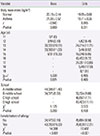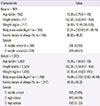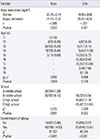Abstract
Purpose
The current study investigated the association of body mass index with asthma and allergic diseases among adolescents in Incheon, South Korea.
Methods
The study sample included 2,140 teenagers living in Incheon. The standard questionnaires of the International Study of Asthma and Allergies in Childhood study were used to survey the prevalence of asthma, allergic rhinitis, and atopic dermatitis. In addition, family history of allergic diseases, height, and weight were collected via self-report.
Results
The average body mass index was higher in male adolescents with asthma (21.38 kg/m2) than in those without (20.19 kg/m2). Body mass index of male adolescents was associated asthma and atopic dermatitis (odds ratio [OR], 1.074; 95% confidence interval [CI], 1.008-1.143; P=0.026 for asthma and OR, 1.072; 95% CI, 0.998-1.150; P=0.056 for atopic dermatitis) after adjustment for family history of allergic diseases, age, and school as covariates.
Figures and Tables
Table 2
Prevalence of asthma by weight status, age, school, and family history of allergy among adolescents by gender

Table 3
Prevalence of allergic rhinitis by weight status, age, school, and family history of allergy among adolescents by gender

References
1. World Health Organization. Global surveillance, prevention and control of chronic respiratory diseases: a comprehensive approach [Internet]. Geneva: World Health Organization;c2014. cited 2013 Oct 25. Available from: http://www.who.int/respiratory/publications/global_surveillance/en/index.html.
2. Pearce N, Ait-Khaled N, Beasley R, Mallol J, Keil U, Mitchell E, et al. Worldwide trends in the prevalence of asthma symptoms: phase III of the International Study of Asthma and Allergies in Childhood (ISAAC). Thorax. 2007; 62:758–766.

3. Bjorksten B, Clayton T, Ellwood P, Stewart A, Strachan D. ISAAC Phase III Study Group. Worldwide time trends for symptoms of rhinitis and conjunctivitis: Phase III of the International Study of Asthma and Allergies in Childhood. Pediatr Allergy Immunol. 2008; 19:110–124.

4. Williams H, Stewart A, von Mutius E, Cookson W, Anderson HR. International Study of Asthma and Allergies in Childhood (ISAAC) Phase One and Three Study Groups. Is eczema really on the increase worldwide? J Allergy Clin Immunol. 2008; 121:947–954.e15.

5. Suh SH. Prevalence of allergic diseases in Korean children, 2010. Public Health Wkly Rep. 2011; 4:425–431.
6. Yusuf S, Hawken S, Ounpuu S, Dans T, Avezum A, Lanas F, et al. Effect of potentially modifiable risk factors associated with myocardial infarction in 52 countries (the INTERHEART study): case-control study. Lancet. 2004; 364:937–952.

7. Breymaier SO. AMA adopts new policies on second day of voting at Annual Meeting: obesity as a disease [Internet]. Chicago: American Medical Association;c1995-2014. cited 2013 Oct 22. Available from: http://www.ama-assn.org/ama/pub/news/news/2013/2013-06-18-new-ama-policies-annual-meeting.page.
8. Yao TC, Ou LS, Yeh KW, Lee WI, Chen LC, Huang JL, et al. Associations of age, gender, and BMI with prevalence of allergic diseases in children: PATCH study. J Asthma. 2011; 48:503–510.

9. Tanaka K, Miyake Y, Arakawa M, Sasaki S, Ohya Y. U-shaped association between body mass index and the prevalence of wheeze and asthma, but not eczema or rhinoconjunctivitis: the ryukyus child health study. J Asthma. 2011; 48:804–810.

10. Chang KJ, Koo HS, Lee HS, Jo YA. Association between asthma and obesity in national health and nutrition survey. Korean J Asthma Allergy Clin Immunol. 2005; 25:262–268.
11. Kilpelainen M, Terho EO, Helenius H, Koskenvuo M. Body mass index and physical activity in relation to asthma and atopic diseases in young adults. Respir Med. 2006; 100:1518–1525.

12. Yoo S, Kim HB, Lee SY, Kim BS, Kim JH, Yu JH, et al. Association between obesity and the prevalence of allergic diseases, atopy, and bronchial hyperresponsiveness in Korean adolescents. Int Arch Allergy Immunol. 2011; 154:42–48.

13. Lugogo NL, Kraft M, Dixon AE. Does obesity produce a distinct asthma phenotype? J Appl Physiol (1985). 2010; 108:729–734.

14. Kim SH, Yoon HJ. Obese asthma patients: a notable phenotype of asthma. Korean J Asthma Allergy Clin Immunol. 2010; 30:79–85.
15. Melen E, Granell R, Kogevinas M, Strachan D, Gonzalez JR, Wjst M, et al. Genome-wide association study of body mass index in 23 000 individuals with and without asthma. Clin Exp Allergy. 2013; 43:463–474.
16. Online Survey of Adolescent Health Behaviors. Survey result: statistics: prevalence of obesity [Internet]. Seoul: Ministry of Education;c2014. cited 2013 Oct 10. Available from: http://yhs.cdc.go.kr/.
17. Chua KP, Schuster MA, McWilliams JM. Differences in health care access and utilization between adolescents and young adults with asthma. Pediatrics. 2013; 131:892–901.

18. Halterman JS, Riekert K, Bayer A, Fagnano M, Tremblay P, Blaakman S, et al. A pilot study to enhance preventive asthma care among urban adolescents with asthma. J Asthma. 2011; 48:523–530.

19. Korea Centers for Disease Control and Prevention, Division of Chronic Disease Surveillance, Committee for the Development of Growth Standard for Korean Children and Adolescents. Korean Pediatric Society, Committee for School Health and Public Health Statistics. 2007 Korean children and adolescents growth standard (commentary for the development of 2007 growth chart). Cheongwon: Korea Centers for Disease Control and Prevention, Division of Chronic Disease Surveillance;2007.
20. Batty GD, Shipley MJ, Gunnell D, Huxley R, Kivimaki M, Woodward M, et al. Height, wealth, and health: an overview with new data from three longitudinal studies. Econ Hum Biol. 2009; 7:137–152.

21. Tilg H, Moschen AR. Adipocytokines: mediators linking adipose tissue, inflammation and immunity. Nat Rev Immunol. 2006; 6:772–783.

22. Akdis CA, Blaser K, Akdis M. Apoptosis in tissue inflammation and allergic disease. Curr Opin Immunol. 2004; 16:717–723.

23. Brown V, Warke TJ, Shields MD, Ennis M. T cell cytokine profiles in childhood asthma. Thorax. 2003; 58:311–316.

24. Leung DY, Boguniewicz M, Howell MD, Nomura I, Hamid QA. New insights into atopic dermatitis. J Clin Invest. 2004; 113:651–657.

25. Sampson HA. Atopic dermatitis: immunological mechanisms in relation to phenotype. Pediatr Allergy Immunol. 2001; 12:Suppl 14. 62–68.

26. Irei AV, Sato Y, Lin TL, Wang MF, Chan YC, Hung NT, et al. Overweight is associated with allergy in school children of Taiwan and Vietnam but not Japan. J Med Invest. 2005; 52:33–40.

27. Leung TF, Kong AP, Chan IH, Choi KC, Ho CS, Chan MH, et al. Association between obesity and atopy in Chinese schoolchildren. Int Arch Allergy Immunol. 2009; 149:133–140.

28. Henkin S, Brugge D, Bermudez OI, Gao X. A case-control study of body mass index and asthma in Asian children. Ann Allergy Asthma Immunol. 2008; 100:447–451.

29. Kang H, Kang EK, Nah KM, Yoo Y, Koh YY. Comparison of obesity between children with asthma and healthy children. Pediatr Allergy Respir Dis. 2003; 13:17–25.
30. Szroniak A, Labedzka I, Breborowicz A, Niedziela M. Is body mass index associated with asthma in children? Pneumonol Alergol Pol. 2008; 76:88–95.
31. Kwon JW, Kim SH, Kim TB, Kim SH, Park HW, Chang YS, et al. Airway hyperresponsiveness is negatively associated with obesity or overweight status in patients with asthma. Int Arch Allergy Immunol. 2012; 159:187–193.

32. Yoo Y, Ko HK, Han JJ, Lee Y, Seo KJ, Choung JT, et al. The prevalence of atopy and asthma among university freshmen in Seoul, Korea: association with obesity. J Asthma. 2007; 44:45–49.

33. Jang AS, Son MH, Choi IS, Koh YI. High body mass index is associated with wheezing among older adults living in high-altitude area in Korea. J Korean Med Sci. 2002; 17:479–482.

34. Kim KM, Kim SS, Kwon JW, Jung JW, Kim TW, Lee SH, et al. Association between subcutaneous abdominal fat and airway hyperresponsiveness. Allergy Asthma Proc. 2011; 32:68–73.

35. Fukutomi Y, Taniguchi M, Nakamura H, Konno S, Nishimura M, Kawagishi Y, et al. Association between body mass index and asthma among Japanese adults: risk within the normal weight range. Int Arch Allergy Immunol. 2012; 157:281–287.

36. Hancox RJ, Milne BJ, Poulton R, Taylor DR, Greene JM, McLachlan CR, et al. Sex differences in the relation between body mass index and asthma and atopy in a birth cohort. Am J Respir Crit Care Med. 2005; 171:440–445.

37. Baek JO, Hong S, Son DK, Lee JR, Roh JY, Kwon HJ. Analysis of the prevalence of and risk factors for atopic dermatitis using an ISAAC questionnaire in 8,750 Korean children. Int Arch Allergy Immunol. 2013; 162:79–85.

38. Xiong M, Ni C, Pan JH, Wang Q, Zheng LL. Risk factors for asthma in children in Hefei, China. Zhongguo Dang Dai Er Ke Za Zhi. 2013; 15:364–367.




 PDF
PDF ePub
ePub Citation
Citation Print
Print





 XML Download
XML Download